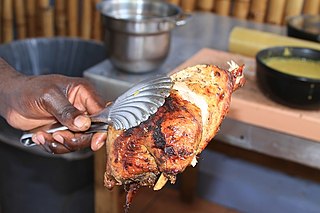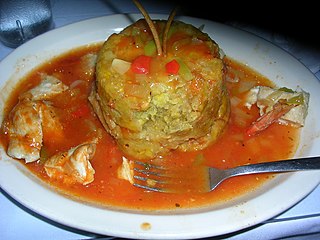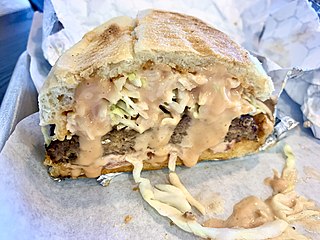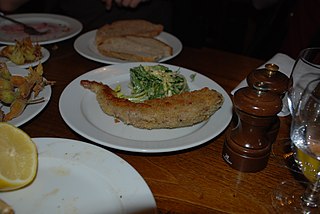
Cooking bananas are a group of starchy banana cultivars in the genus Musa whose fruits are generally used in cooking. They are not eaten raw and generally starchy. Many cooking bananas are referred to as plantains or 'green bananas'. In botanical usage, the term "plantain" is used only for true plantains, while other starchy cultivars used for cooking are called "cooking bananas". True plantains are cooking cultivars belonging to the AAB group, while cooking bananas are any cooking cultivar belonging to the AAB, AAA, ABB, or BBB groups. The currently accepted scientific name for all such cultivars in these groups is Musa × paradisiaca. Fe'i bananas from the Pacific Islands are often eaten roasted or boiled, and are thus informally referred to as "mountain plantains", but they do not belong to any of the species from which all modern banana cultivars are descended.

The Kalinago, formerly known as Island Caribs or simply Caribs, are an Indigenous people of the Lesser Antilles in the Caribbean. They may have been related to the Mainland Caribs (Kalina) of South America, but they spoke an unrelated language known as Island Carib. They also spoke a pidgin language associated with the Mainland Caribs.

Juan Ponce de León was a Spanish explorer and conquistador known for leading the first official European expedition to Puerto Rico in 1508 and Florida in 1513. He was born in Santervás de Campos, Valladolid, Spain, in 1474. Though little is known about his family, he was of noble birth and served in the Spanish military from a young age. He first came to the Americas as a "gentleman volunteer" with Christopher Columbus's second expedition in 1493.

Teppanyaki, often called hibachi in the United States and Canada, is a post-World War II style of Japanese cuisine that uses an iron griddle to cook food. The word teppanyaki is derived from teppan, the metal plate on which it is cooked, and yaki, which means grilled, broiled, or pan-fried. In Japan, teppanyaki refers to dishes cooked using a teppan, including steak, shrimp, okonomiyaki, yakisoba, and monjayaki.

A cookbook or cookery book is a kitchen reference containing recipes.

Puerto Rican cuisine consists of the cooking style and traditional dishes original to Puerto Rico. It has been primarily a fusion influenced by the ancestors of the Puerto Rican people: the indigenous Taínos, Spanish Criollos and sub-Saharan African slaves. As a territory of the United States, the culinary scene of Puerto Rico has also been moderately influenced by American cuisine.

Roti is a round flatbread originating from the Indian subcontinent. It is commonly consumed in many South Asian, Southeast Asian, Caribbean, and Southeast African countries.

The region known as Hispanic America and historically as Spanish America is all the Spanish-speaking countries of the Americas. In all of these countries, Spanish is the main language - sometimes sharing official status with one or more indigenous languages or English, and Latin Catholicism is the predominant religion.

A quesadilla is a Mexican dish consisting of a tortilla that is filled primarily with cheese, and sometimes meats, spices, and other fillings, and then cooked on a griddle or stove. Traditionally, a corn tortilla is used, but it can also be made with a flour tortilla.

Cuban cuisine is largely based on Spanish cuisine with influence from Taino, African and other Caribbean cuisines. Some Cuban recipes share spices and techniques with Spanish, Taino and African cooking, with some Caribbean influence in spice and flavor. This results in a blend of several different cultural influences. A small but noteworthy Chinese influence can also be accounted for, mainly in the Havana area. There is also some Italian influence. During colonial times, Cuba was an important port for trade, and the Spanish ancestors of Cubans brought with them the culinary traditions of different parts of Spain.

Latin American cuisine is the typical foods, beverages, and cooking styles common to many of the countries and cultures in Latin America. Latin America is a highly racially, ethnically, and geographically diverse with varying cuisines. Some items typical of Latin American cuisine include maize-based dishes arepas, empanadas, pupusas, tacos, tamales, tortillas and various salsas and other condiments. Sofrito, a culinary term that originally referred to a specific combination of sautéed or braised aromatics, exists in Latin American cuisine. It refers to a sauce of tomatoes, roasted bell peppers, garlic, onions and herbs. Rice, corn, pasta, bread, plantain, potato, yucca, and beans are also staples in Latin American cuisine.

Jerk is a style of cooking native to Jamaica, in which meat is dry-rubbed or wet marinated with a hot spice mixture called Jamaican jerk spice.

Puerto Rican Spanish is the variety of the Spanish language as characteristically spoken in Puerto Rico and by millions of people of Puerto Rican descent living in the United States and elsewhere. It belongs to the group of Caribbean Spanish variants and, as such, is largely derived from Canarian Spanish and Andalusian Spanish. Outside of Puerto Rico, the Puerto Rican accent of Spanish is also commonly heard in the U.S. Virgin Islands and many U.S. mainland cities like Orlando, New York City, Philadelphia, Miami, Tampa, Boston, Cleveland, and Chicago, among others. However, not all stateside Puerto Ricans have knowledge of Spanish. Opposite to island-born Puerto Ricans who primarily speak Spanish, many stateside-born Puerto Ricans primarily speak English, although many stateside Puerto-Ricans are fluent in Spanish and English, and often alternate between the two languages.

Mofongo is a dish from Puerto Rico with plantains as its main ingredient. Plantains are picked green, cut into pieces and typically fried but can be boiled or roasted, then mashed with salt, garlic, broth, and olive oil in a wooden pilón. The goal is to produce a tight ball of mashed plantains that will absorb the attending condiments and have either pork cracklings (chicharrón) or bits of bacon inside. It is traditionally served with fried meat and chicken broth soup. Particular flavors result from variations that include vegetables, chicken, shrimp, beef, or octopus packed inside or around the plantain orb.
At the time of first contact between Europe and the Americas, the Indigenous peoples of the Caribbean included the Taíno of the northern Lesser Antilles, most of the Greater Antilles and the Bahamas, the Kalinago of the Lesser Antilles, the Ciguayo and Macorix of parts of Hispaniola, and the Guanahatabey of western Cuba. The Kalinago have maintained an identity as an Indigenous people, with a reserved territory in Dominica.

Johnnycake, also known as journey cake, johnny bread, hoecake, shawnee cake or spider cornbread, is a cornmeal flatbread, a type of batter bread. An early American staple food, it is prepared on the Atlantic coast from Newfoundland to Jamaica. The food originates from the indigenous people of North America. It is still eaten in the Bahamas, Belize, Nicaragua, Bermuda, Canada, Colombia, Curaçao, Dominican Republic, Jamaica, Puerto Rico, Saint Croix, Sint Maarten, Antigua, and the United States.

The culture of Puerto Rico is the result of a number of internal and indigenous influences, both past and present. Modern cultural manifestations showcase the island's rish history and help create an identitu that is uniquely Puerto Rican - Taíno, Spanish, African, and North American.

Dominican cuisine is made up of Spanish, Indigenous Taíno, Middle Eastern, and African influences. The most recent influences in Dominican cuisine are from the British West Indies and China.

The Taíno were a historic indigenous people of the Caribbean, whose culture has been continued today by Taíno descendant communities and Taíno revivalist communities. At the time of European contact in the late 15th century, they were the principal inhabitants of most of what is now Cuba, the Dominican Republic, Jamaica, Haiti, Puerto Rico, the Bahamas, and the northern Lesser Antilles. The Lucayan branch of the Taíno were the first New World peoples encountered by Christopher Columbus, in the Bahama Archipelago on October 12, 1492. The Taíno historically spoke a dialect of the Arawakan language group. They lived in agricultural societies ruled by caciques with fixed settlements and a matrilineal system of kinship and inheritance. Taíno religion centered on the worship of zemis.

Pig tail, also referred to as pigtail and pork tail, are the tails from a pig used as a food ingredient in many cuisines. Pig tails can be smoked, fried, or roasted in barbecue sauce.


















